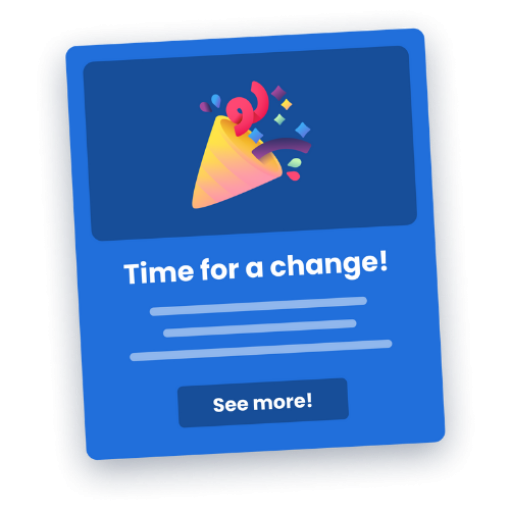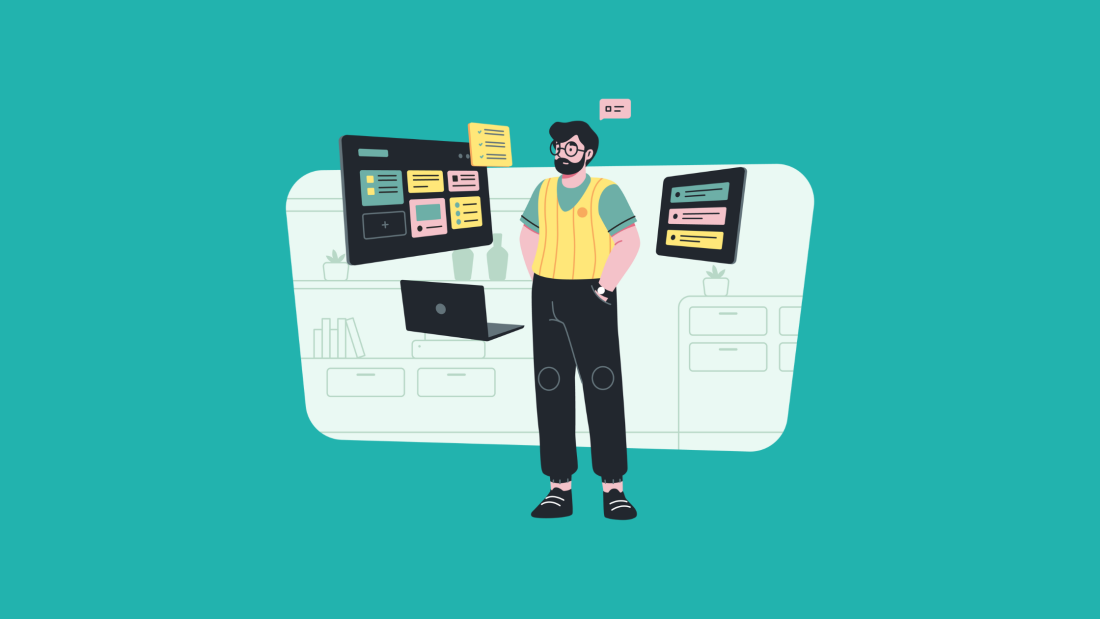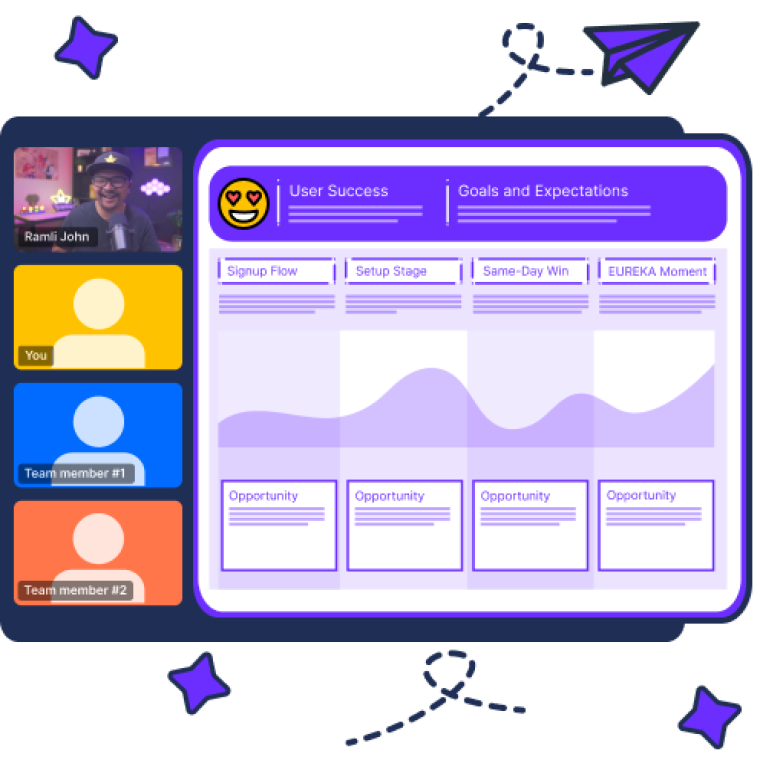A free trial period is used by most SaaS businesses today and with good reason. However, there are still some companies that don’t offer a SaaS free trial. And that’s okay, too!
In this article, we’ll explore when and why you should offer a free trial, along with everything you need to know about how to keep users engaged and increase free-to-paid conversions.
We’ll set the foundation with the free trial definition and move on to answer the questions of whether you should offer a free trial or not, what the ideal free trial length is, how to get more signups, how to keep users engaged, and how to increase free-to-paid conversion rates. Let’s get into it.
A free trial period grants users access to your SaaS product for a limited time, and it’s a great way to drive potential paying customers to their “aha!” moment.
Should you consider offering a free trial or a freemium plan? We’ll go through each option below with quick checklists to help you decide.
When it comes to free trial length, there’s no one-size-fits-all solution. It’s largely dependent on the average time it takes your users to reach their “aha!” moment and activate within your app.
We’ll walk you through actionable steps and tactics to help you attract more free trial signups, activate free trial users more quickly, and keep them engaged throughout.
Last but not least, we’ll cover six ways to increase your free trial conversion rate.
What is a free trial period?
A free trial period grants users access to your SaaS product for a limited time, often with restricted access to features. A free trial period helps potential customers understand if a SaaS product will fulfill their needs and whether it’s worth paying for.
SaaS businesses use a free trial period to drive potential paying users to their “aha!” moment and to help them find value in the product’s capabilities.
Should you offer a free trial for your SaaS product?
For the most part, yes. All SaaS companies should consider offering a free trial or, at least, a freemium version of their product. Now, what you decide to include and gate in your free trial is entirely up to you. It will depend on your business model, product features, pricing model, and users.
Free trial vs. Freemium model
First, let’s examine the difference between a free trial period and a freemium model. A free trial offers time-limited access, while a freemium model isn’t time-constrained but offers limited feature use.
When should you use each? For example, if you’re developing a strategy to attract new users, then a free trial or freemium will well put you on your way.
Let’s take a look at more scenarios when you should consider one of these solutions—or both, depending on the audiences you serve and your user personas.
Offering a freemium plan can be a good solution for you if…
You offer self-serve and tech-touch support in-product
Your product has a low or manageable learning curve
Your product can sell itself, driving acquisition from within
Your product is free-standing or easy to integrate with other tools
Offering a free trial period can be a good solution for you if…
You want to offer a “try before you buy” option to your users
Your product requires technical expertise to set it all up
The learning curve is steep and onboarding requires human support
Your product is difficult to navigate and takes time for users to get it going
With these checklists above, you’ll have a better understanding of whether you’re in a good place to consider implementing a free trial.
Still with us? Fab, let’s keep going.
What is the ideal length for a free trial period?
Although there is no proven ideal free trial period length, there are certainly some common practices within the SaaS industry that we’ve seen emerge over recent years:
A shorter trial period typically lasts 7-14 days, up to 30 days
A longer trial period can reach as many as 90 days
💡Pro tip: In the time of economic downturn, some of the SaaS companies have begun offering, for instance, 6 months of free usage for a 2-year contract.
Even though this isn’t a typical free trial, it serves as an incentive and can be a good way to get more leads and close more deals.
For a detailed look into how SaaS companies can weather the recession storm and come out as winners (and why product adoption is essential), read our article.
There’s no one-size-fits-all solution here as it’s largely dependent on the average time it takes your users to reach their “aha!” moment and activate within your app.
Make the free trial period too short, and you run the risk of the user not finding value in time and not embedding your product in their job-to-be-done routine.
Keep it too long, and you risk free-trial churn. This means more people abandon your product before they get a chance to transition to paid plans. If you can’t keep a user on a free plan, then you stand little to no hope of getting them to join a paid plan.
Regardless of your free trial length, it’s more important to create a strategy that will encourage free trial signups, activate users more quickly or onboard freemium users efficiently, and lay an incredible user experience on the table for them.
With that being said, let’s take a look at how you can win more free trial signups.
How to attract more free trial signups
Attracting free trial users is where your marketing team efforts come into play.
Strategies for attracting more free signups typically include:
Growth generation: Content marketing, community building, paid advertising
Demand generation: Inbound marketing, SEO, social media, lead scoring
Lead generation: Retargeting, exit intent pop-ups, email flows, sales collateral
Besides these strategies, you might also want to win conversions from within your product by recognizing upsell and upgrade opportunities based on user behavior and pushing more product qualified leads (PQLs) through your doors. This would require minimal marketing materials, and it would be a baseline for your product-led growth (PLG) strategy.
It’s well worth noting that users interested in free signups are no less valuable than those that jump straight into a paid plan.
In today’s heavily saturated SaaS world, people do their research before investing in a product, no matter how well it’s being marketed. This means your free trial will probably be running alongside some of your competitors. It’s an active form of research and evaluation process for your prospective customers.
How to quickly activate free trial users
User activation is when a user successfully completes an action within your product that helps them understand your product value. This doesn’t need to be one action, it can be multiple different actions or a set of pre-defined milestones, depending on the needs of each user.
Activating a user within your product is a strong signal that they’ll convert into a paid user. If you’re using an engagement scoring system then a collection of high-intent actions can add up and suggest a user is ready to put their cash on the table.
Every SaaS free trial, even with limited core features, should include activation opportunities—and plenty of them.
In-app messaging should be top of your list for increased activation rates. Onboarding the free trial users is crucial for promoting a self-serve product and enabling them with the knowledge they need to activate on their own.

Boost product adoption with in-app messaging
Get started free with Chameleon and harness the power of product tours, tooltips, checklists, and surveys.
You have a couple of options when it comes to activation-orientated onboarding.
Low-touch user onboarding
Best for easy-to-navigate products, this style of onboarding comes via using tooltips as a way to edge news along their pathways to activate within your product. It’s less invasive, and it empowers users to find their own feet.
High-touch tech onboarding
It is more hands-on, even if they’re digital hands, and is best exemplified via a product tour or launcher. These types of onboarding methods can essentially be micro product demos tailored to the user’s needs, around the core features they’ve got access to. They’re a good fit if your product interface can be overwhelming, and they explicitly show someone where their “aha!” moment is hiding.
High-touch human onboarding
This is when your sales teams will come in to guide users through their first in-app experience. It’s a good nurture opportunity as sales reps can directly combat users’ doubts and worries about your product. This product demo-style onboarding method is hyper-personal, although sometimes difficult to scale.
How to keep users engaged throughout a free trial
We’ve come to the age-old SaaS question: How do you keep users engaged? A successful free trial needs to fight churn rates in those first few in-app product moments and throughout the entire free trial.
There are a few sure-fire tactics you can use to help maintain and even increase user engagement within their free trial experience. Let’s take a look at each.
Build bowling lanes
The bowling alley framework guides users to their specific job-tobe-done. This means each lane has a tailored journey to enable the user (the bowling ball) to hit a strike at the end. You will need to accurately segment users based on their needs for this methodology to work.
What keeps your engagement rates up is keeping the lane bumpers up. These bumpers can be conversational bumpers, in-product bumpers, or even emails—all of which are designed to stop the user from dropping off their path and keep them on track to success.
Gamify the user experience
Bring a pinch of fun to your onboarding flows by gamifying the user experience. You can offer incentives (real-life rewards or a redeemable in-product points system). You can also consider other gamification tactics like challenges, levels, leaderboards, celebrations, and more.
Stagger user onboarding
Pace out the in-app messages or create several shorter product tours (instead of one longer) to keep users engaged and not overwhelmed by information. Especially if you’ve got a complicated tool, it’s a good idea to spoon-feed new users and introduce them to their most important feature first. The rest can wait for a return visit.
Create triggered events
This encourages users to click and explore your product on their own terms. When users know you’re there to guide their more complicated steps, they’ll continue to take them with confidence.
When you guide users through their free trial with these tactics, you’ll ensure they’ll reach the end of their allotted time with an engagement rate as strong as it was on day one, if not higher.
A few engagement metrics worth tracking at this point include adoption rates, churn rates, onboarding completion rates, time spent in-app, time to value (TTV), and more.
How to increase free-to-paid conversions
Last, but not least, the money maker question: How do you convert all of these happy, highly engaged free-trial users to paying customers?
Here are six ways to increase your free trial conversion rate.
1. Know your users
A free trial period is a perfect opportunity to get a deep understanding of your users’ needs. By understanding their in-product actions, you’ll be able to better personalize their pathway to a paying customer.
2. Segment users by personas
Segmentation will also help you deliver better free trial experiences the first time around. By understanding the different types of users your product attracts you can better speak their language, address their needs, and offer them payment plans that suit their preferences.
3. Offer an unbeatable free trial experience
We’ll say it time and time and again—if you hope to increase your free trial conversion rate it means delivering an experience second to none. Ensure your UI and UX are the best in the show. It’s a good idea to set up triggered feedback Microsurveys to highlight where things are running smoothly and where they need work. Here’s an example of a Microsurvey built with Chameleon.
4. Use in-product announcements for upselling opportunities
Free-to-paid conversions don’t have to come at the end of a trial period. Why wait to convert trial users if they’re ready now? Use in-product marketing tactics and in-app messages to offer sign-up opportunities to your users and get them on to a paid plan—with more benefits for them—quicker.

💸 Trigger upsell modals based on customer behavior
Learn how to use Chameleon, Mixpanel, and HubSpot to drive revenue by targeting your most relevant users with personalized upsell nudges.
5. Find the right blend of motivation, ability, and training
Research shows that with the right blend of motivation, ability, and training any habit can be informed and any behavior changed. Keep this in mind as you navigate your free trial experience and ready your user for the sales team.
The right blend of reminding users of their problems, amplifying their ability with your product features, and demonstrating your product and feature value will give you the opportunity to turn the usage of your product into a habit for users.
6. Make conversion easy
Easier said than done, offering access to advanced features will never be enough if the process of getting there is clunky or click-heavy.
Here are some of the tactics to help you optimize the conversion flows:
Remove unnecessary fields from signup forms
Offer multiple payment options
Use social proof to eliminate doubts
Remove distractions from sign-up pages
Use consistent, clear, and minimal CTAs
As you go about trying one or all of these tactics, keep in mind that your goal here is to make the conversion easy for your users.
Use data wisely and make the most of your free trial
We’ll close out with a reminder to use your data wisely when implementing a free trial and strategizing ways to up your conversion rate.
This data can be collected through quantitative in-app prompts to affirm or disprove your hypothesis. However, it can also include qualitative feedback from users, be they current, potential, or even churned!
Make the most of the information you have and convert it into actionable steps to build a free trial period that wins paid conversions for your SaaS.

Increase your free trial conversions
Create outstanding onboarding flows and in-product experiences with Chameleon's easy-to-use editor. Help your users understand the product value quickly and drive more free-to-paid conversions.






